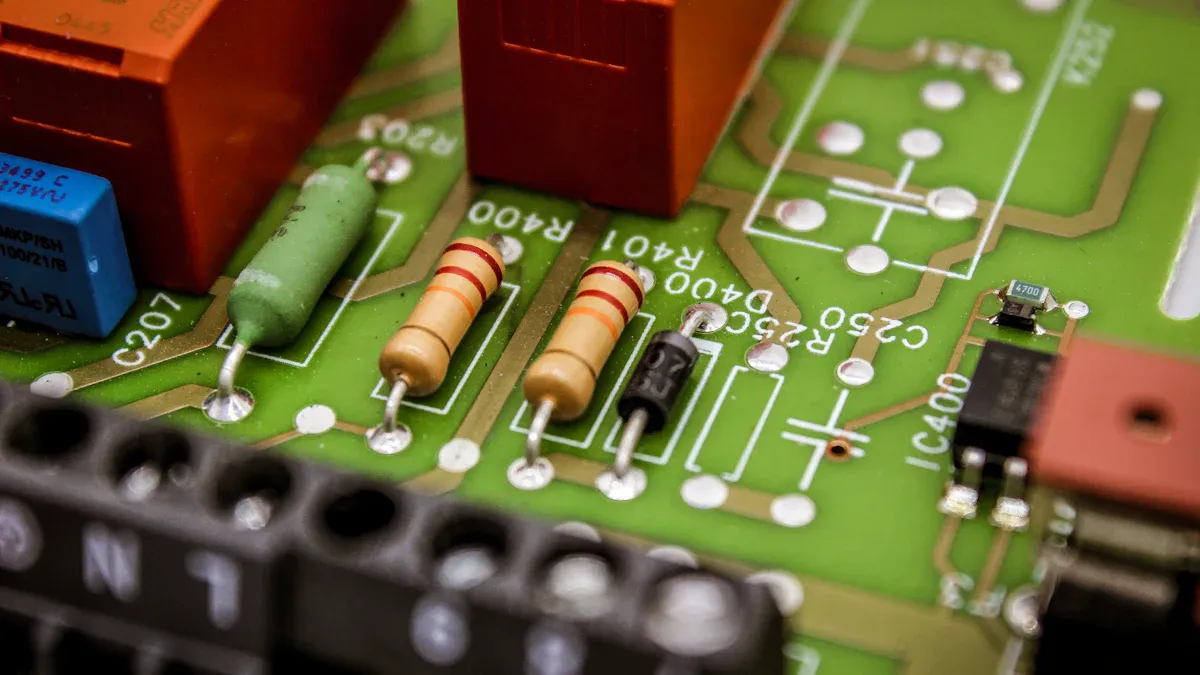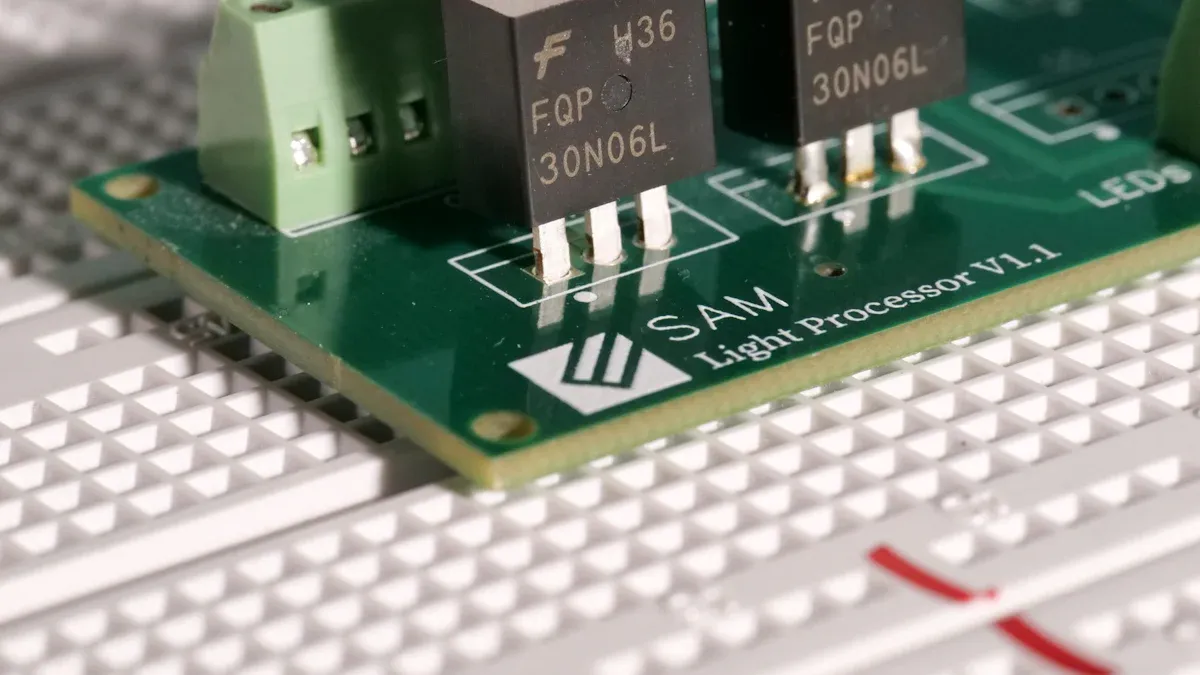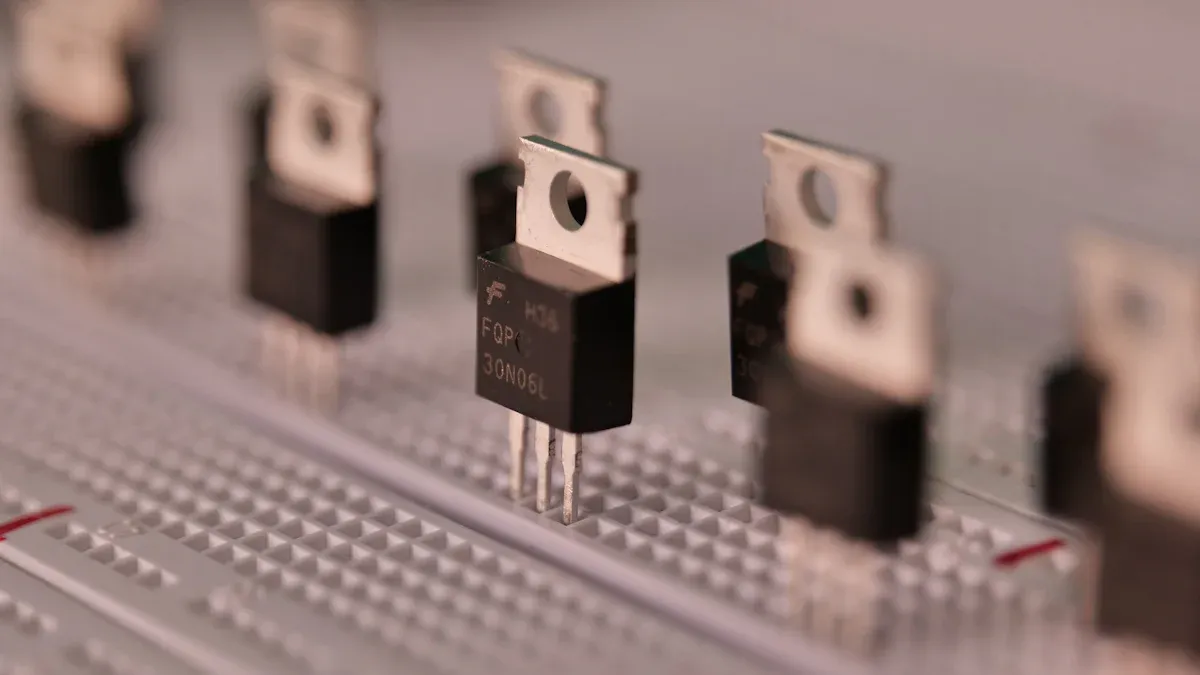Mastering MOSFET Basics for Electronics Enthusiasts

A MOSFET, or Metal-Oxide-Semiconductor Field-Effect Transistor, is important in electronics. It works like a gate, controlling electrical signals. This helps with switching and making signals stronger. MOSFETs are used in many devices, like phones and electric cars.
They are becoming more useful as industries need smaller, energy-saving tools. For example:
The MOSFET market was worth $7.6 billion in 2023. It might grow to $18.6 billion by 2033, with a yearly growth rate of 9.3%.
Super-Junction MOSFETs have changed power electronics. They lower resistance and make switching faster, which is great for quick tasks.
MOSFETs switch quickly and handle heat well. They are key for things like motor control and green energy systems.
Key Takeaways
MOSFETs are important parts in electronics. They work as switches or amplifiers to manage electrical signals.
Picking the right MOSFET for your project is very important. Look at voltage limits, efficiency, and if it fits your circuit.
Don’t make common mistakes like overloading or wrong connections. These can stop your MOSFET circuits from working well.
Testing your MOSFET circuits matters a lot. Check wires and voltages to fix any problems.
MOSFETs are becoming more popular because they save energy and can do many jobs, like controlling motors or boosting signals.
Understanding MOSFETs

What is a MOSFET?
A MOSFET is a special transistor used in circuits. It controls how electricity moves, acting as a switch or amplifier. It has three main parts: gate, source, and drain. The gate works like a control knob, letting current flow when voltage is applied. This makes MOSFETs great for switching and boosting signals.
MOSFETs are found in many devices, like phones and electric cars. They work well at high speeds and save energy. This makes them perfect for motor control, power changes, and signal handling.
Key components: Gate, Drain, Source, and Substrate
MOSFETs have four main parts, each with a job:
Part | Job it does |
|---|---|
Gate | Controls current flow |
Drain | Collects the current |
Source | Sends current into the channel |
Substrate | Supports the MOSFET structure |
The gate is the most important part. It decides if the MOSFET is ON or OFF. Voltage at the gate creates an electric field, letting current move between the source and drain. The substrate, usually made of silicon, holds everything together and keeps it working well.
New designs, like nanosheets and strain engineering, make MOSFETs better. Scientists are also testing materials like graphene to improve efficiency and size.
Why MOSFETs are widely used in electronics
MOSFETs are popular because they work better than some other parts, like IGBTs.
Feature | MOSFETs | IGBTs |
|---|---|---|
Heat Handling | Great at high speeds | Better for big power tasks |
Energy Loss | Lower at small currents | Higher at small currents |
Switching Speed | Faster | Slower |
Best Uses | Small converters, signal amplifiers | Big power systems |
MOSFETs are great for fast switching and saving energy. Enhancement mode MOSFETs, which start OFF, are common in digital circuits and power systems. They are efficient and flexible, making them very useful in electronics.
Studies show how MOSFETs have improved over time. For example:
MOSFETs help switch or boost signals in phones and computers.
Research has looked at how CMOS devices handle electrical stress.
SiC MOSFETs improve heat handling and make semiconductors more advanced.
These reasons show why MOSFETs are so important in electronics and keep getting better with new ideas.
Types of MOSFETs
N-channel and P-channel MOSFETs
MOSFETs are of two main types: N-channel and P-channel. These types depend on the charge carriers inside them. In N-channel MOSFETs, electrons carry the current. In P-channel MOSFETs, holes (positive charges) carry the current.
N-channel MOSFETs are more common because they work faster. Electrons move quicker than holes, making them more efficient. They also waste less energy as heat due to lower resistance. P-channel MOSFETs are used when controlling positive voltage in circuits.
A study on special double-gate MOSFETs shows their differences. Both types are great for low-power tasks. But N-channel MOSFETs are faster and more efficient. This makes them better for high-speed jobs.
Depletion-mode MOSFETs
Depletion-mode MOSFETs are special because they start "ON." Current flows even without voltage at the gate. To turn it "OFF," you apply a negative voltage (N-channel) or positive voltage (P-channel).
These MOSFETs are rare but useful in certain cases. They work well in circuits needing a default "ON" state. For example, they are used in constant current sources.
Enhancement-mode MOSFETs
Enhancement-mode MOSFETs are the most common type. Unlike depletion-mode, they start "OFF." You must apply voltage to the gate to turn them "ON." For instance, in an N-channel enhancement-mode MOSFET, a positive gate voltage allows current flow.
These MOSFETs are popular for their efficiency and flexibility. They use less power, switch faster, and are smaller than older parts like BJTs.
Feature | Enhancement-Mode MOSFETs | BJTs |
|---|---|---|
Input Current | Needs almost no input current | Needs constant input current |
Control | Voltage increases conductivity | Needs current for control |
Size | Very small | Larger |
Power Use | Uses less power | Uses more power |
Switching Speed | Switches faster | Switches slower |
Thermal Issues | No thermal runaway | Can have thermal runaway |
Input Impedance | Very high | Lower |
Stage Isolation | Good isolation between stages | Can cause stage loading |
The oxide layer in enhancement-mode MOSFETs blocks DC current at the gate. This saves power and increases input impedance. These features make them perfect for fast and efficient digital circuits.
How MOSFETs Work
Gate voltage and current control
The gate of a MOSFET controls how current flows. Adding voltage to the gate creates an electric field. This field lets current move between the source and drain. The more voltage you add, the more current flows.
You can learn more about this using simulations:
The MPLAB Mindi Analog Simulator shows how gate voltage works.
A boost converter simulation shows how a microcontroller controls a MOSFET. It lets you see how gate voltage changes and affects current.
Using a TC4427 MOSFET Driver in simulations makes switching faster. It also improves efficiency by reducing delay times.
These tools help you understand how gate voltage controls current in circuits.
How depletion-mode MOSFETs work
Depletion-mode MOSFETs are "ON" by default. Current flows even when no voltage is at the gate. To turn it "OFF," you apply the opposite voltage. For N-channel types, you use a negative voltage.
This MOSFET works by reducing charge carriers in the channel. Adding the right voltage removes carriers, stopping the current. These MOSFETs are rare but useful. They are great for circuits needing a default "ON" state, like constant current sources.
How enhancement-mode MOSFETs work
Enhancement-mode MOSFETs are the most common type. They start "OFF," so no current flows without gate voltage. For N-channel types, adding positive voltage creates a path for current.
An oxide layer blocks DC current from entering the gate. This saves energy and makes the MOSFET more efficient. Studies, like "Theoretical Study and Simulation of on-chip MOSFET's as Hall Effect Sensors," explain how these MOSFETs work in different uses.
Enhancement-mode MOSFETs are great for fast switching and saving power. Their flexibility makes them important in modern electronics.
Practical Applications of MOSFETs

MOSFETs are important in today's electronics. They are flexible and efficient. You can use them to control motors, switch circuits, or make signals stronger. Let’s look at some common uses.
MOSFET motor control: Basics and circuit examples
MOSFETs are great for motor control because they handle high currents. They also switch on and off very quickly. In motor systems, MOSFETs act like switches to manage power. This helps control the motor's speed, direction, and strength.
For example, in a DC motor circuit, an N-channel MOSFET connects to the motor. A pulse-width modulation (PWM) signal controls the MOSFET's gate. The gate turns the MOSFET on and off fast. This changes the voltage sent to the motor, adjusting its speed.
Tip: Use a MOSFET driver for better motor control. It makes switching faster and reduces heat.
Studies show that MOSFET drivers improve motor systems. They make motors work better and last longer.
Using MOSFETs as switches
MOSFETs are excellent switches in circuits. They turn on and off quickly with little energy loss. This makes them useful in power supplies, computers, and EV chargers.
The gate voltage (VGS) decides if the MOSFET is "ON" or "OFF":
A positive VGS turns it "ON," letting current flow.
A zero VGS turns it "OFF," stopping the current.
This is helpful when you need to control current precisely. For example, an N-channel MOSFET can switch a lamp on or off. Add voltage to the gate to turn the lamp on. Remove the voltage to turn it off.
MOSFET switches have key benefits:
No DC current at the gate, thanks to its design.
These features make MOSFETs ideal for cars, computers, and EV chargers.
Using MOSFETs as amplifiers
MOSFETs are also great amplifiers, especially for high-frequency signals. They make weak signals stronger by controlling current flow. This is useful in audio systems, radios, and signal processors.
Compared to BJTs (Bipolar Junction Transistors), MOSFETs have advantages:
Feature | MOSFETs | BJTs |
|---|---|---|
Input Impedance | Higher | Lower |
Switching Speed | Faster | Slower |
Power Dissipation | Lower | Higher |
Thermal Stability | Better | Can overheat |
Control Type | Voltage-controlled | Current-controlled |
Application in Amplifiers | Best for high-frequency | Good for low-noise tasks |
For example, in a common-source amplifier, an N-channel MOSFET boosts a signal. The gate voltage changes the current flow, creating a stronger output signal. This makes MOSFETs very useful for modern electronics.
Tips for Using MOSFETs
Picking the right MOSFET for your project
Choosing the correct MOSFET makes your circuit work well. First, figure out the voltage and current your project needs. For example, in electric cars, silicon carbide (SiC) MOSFETs are best. They switch fast and save energy, making them great for control systems.
Here are some tips to help you choose:
Voltage Rating: Match the MOSFET's voltage rating to your project. Companies group MOSFETs by voltage for better performance.
Efficiency: SiC MOSFETs are very efficient, especially in cars and factories.
Logic-Level Compatibility: For a 5V microcontroller like Arduino, pick a logic-level MOSFET like the ST STP55NF06L.
Tip: Always read the datasheet for gate-source voltage (Vgs) details. For example, the IRFZ44N works best with a Vgs of 10V to 15V.
Avoiding common mistakes with MOSFETs
Mistakes can cause circuits to fail or work poorly. Knowing common errors helps you avoid them.
Overloading: Car systems often push MOSFETs hard. Make sure the MOSFET can handle the highest voltage and current in your circuit.
Manufacturer Differences: Different brands make MOSFETs differently, which affects how they work. Test parts before using them in your design.
Wrong Connections: Using bad materials, like aluminum wires, can cause problems. Copper clips last longer and lower failure risks.
Note: Adding a resistor (like 220-ohm) to the gate protects the MOSFET and limits current.
Testing and fixing MOSFET circuits
Testing makes sure your MOSFET works right. Start by checking the gate-source voltage (Vgs). If it doesn’t switch, check the voltage levels.
Follow these steps to fix problems:
Check Connections: Make sure the gate, source, and drain are wired correctly.
Measure Voltages: Use a multimeter to see if Vgs matches the MOSFET's needs.
Check Heat: Too much heat means overloading or bad cooling.
Tip: Use tools like MPLAB Mindi Analog Simulator to see how MOSFETs behave in different setups.
Testing and fixing problems saves money and makes circuits more reliable. With practice, you’ll get better at using MOSFETs.
Learning MOSFET basics unlocks many opportunities in electronics. These parts are great for switching and boosting signals. They are very important in today’s circuits. You’ve explored their types, how they work, and where they are used. Examples include motor control, making signals stronger, and saving power.
MOSFETs are helping industries grow and improve. For example:
Key Facts | Where They Are Used | Why They Are Growing |
|---|---|---|
Cars | Need for energy-saving devices | |
2032 market size: $2.8 billion | Home Electronics | Better power-saving technology |
Growth rate: 7.2% (2024–2032) | Factories | More electric and hybrid vehicles |
Fast switching and heat control | Phones and Networks | Smaller, smarter tech being made |
MOSFETs work by using voltage at the gate to control current. They can switch or boost signals, making them useful in computers and power systems.
Now it’s your chance to try them out. Build projects, test ideas, and see what MOSFETs can do. With practice, you’ll get better and discover new ways to use them in electronics.
FAQ
What does a MOSFET do in a circuit?
A MOSFET controls the flow of current in a circuit. It acts as a switch or amplifier, depending on how you use it. By adjusting the gate voltage, you can turn the current flow on or off.
How do you know if a MOSFET is damaged?
You can test a MOSFET with a multimeter. Check the gate, source, and drain connections. If the MOSFET doesn’t switch or shows unusual resistance, it might be damaged.
Can you use a MOSFET with an Arduino?
Yes, you can use a MOSFET with an Arduino. Choose a logic-level MOSFET compatible with the Arduino’s 5V output, like the IRLZ44N. This ensures proper switching and efficient operation.
Why are MOSFETs better than BJTs?
MOSFETs are more efficient than BJTs. They use less power, switch faster, and handle heat better. Their high input impedance also makes them ideal for modern electronics.
What is the difference between N-channel and P-channel MOSFETs?
N-channel MOSFETs use electrons as charge carriers, while P-channel MOSFETs use holes. N-channel types are faster and more efficient, making them more common in circuits.
See Also
A Comprehensive Guide to Understanding Communication Chips
Emerging Trends Influencing the Analog IC Sector by 2025
Addressing Obstacles in Military Wireless Communication Systems
